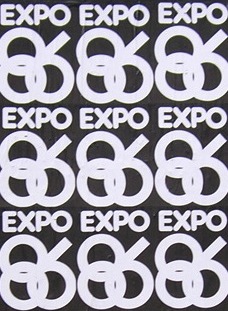Tuesday, April 29, 1986.
YOUR ATTENTION. IT CAN WANDER from just one screen, especially if you're not deeply interested in the sponsor's message.
Since all films at a world's fair are sponsored, they all have messages of one kind or another. To hold your attention, exhibitors developed the multi-screen presentation, a technique that came of age at Expo 67.
Today, fairgoers are less concerned with "how many?" and "how much?'' and more interested in "how well?" Among the Expo 86 attention grabbers are:
◼︎ Rainbow War, in the Canadian Pacific Pavilion's Theatre Two. Producer Bob Rogers's Oscar-nominated 70mm fantasy needs only one screen to beguile an audience. A lively, live-action cartoon, its allegorical plea for tolerance is delightfully realized.
◼︎ Our British Columbia, in the B.C. Pavilion's Challenge Building. A huge, Cinerama-like triptych screen offers a mega-view of this province's industries and its workers. Richard Jeffries directed this 15-minute look at us.
◼︎ The Taming of the Demons, in the Canada Pavilion's Teleglobe Theatre. A spinning globe is surrounded by nine variously-sized screens reflecting Emil Radok's moralizing examination of human communications.
◼︎ The Scroll, in the Pavilion of Promise. Innovative technology turns the fundamentalist Christian message into a series of environmental experiences. Creation, for example, combines a live dance performance with film to produce a variation on Czechoslovakia's famous Laterna Magika. The 13-minute presentation takes place in a mirrored cube that multiplies the images to infinity. A second show, dealing with the life of Christ, uses mirrors to produce the effect of a 34-storey-high screen. Laser-light, film, smoke and more mirrors combine in a third program to give the fairgoer a glimpse of Eternity.
The above is a restored version of a Province Expo 86 preview feature by Michael Walsh originally published in 1986. For additional information on this archived material, please visit my FAQ.
Afterword: For visual artists, attracting and holding an audience's attention remains Job One. In the years since Expo 86, though, multi-screen presentations have fallen from favour. If the news out of the 2016 Cannes Film Festival on Monday (May 16, the sixth day of its 12-day run) is any indication, Virtual Reality is the new focus of entertainment innovators. "It is like right at the beginning of film, but it is going to move very, very quickly," Vincent Leclercq of France's National Centre of Cinematography told AFP reporter Fran Blandy. In what is being described as a "tsunami-sized surge of interest," major money is flooding into companies competing to bring immersive multimedia technologies to market.
As an idea, VR has been a science-fiction staple for decades. Perhaps the best known example is Star Trek's holodeck (first seen in a 1974 episode of Star Trek: The Animated Series). In his 1983 feature film Brainstorm, director Douglas Trumbull (creator of the Showscan process featured at Expo 86), had his characters involved in a sinsiter VR development project. Most of the action in X-Files creator Chris Carter's single-season, shot-in-Vancouver TV series Harsh Realm (1999) is set within a virtual-reality simulation. Looking back, Canadians have played a big part in popularizing VR in the movies. Among the most notable are actor Keanu Reeves, star of 1995's Johnny Mnemonic (adapted from the cyberpunk novel by Vancouver-based author William Gibson) and of all three Matrix movies (1999, 2003), and the directors David Cronenberg (1999's eXistenZ) and James Cameron (2009's Avatar). Looking forward, futurists see possibilities both wondrous and dire.
See also: The 13 articles included in this, the first of four Expo 86 special reports, are:
